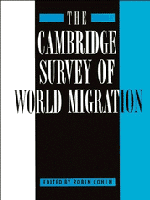Book contents
- Frontmatter
- Contents
- List of illustrations
- List of tables
- Notes on the contributors
- 1 Prologue
- 2 European colonization and settlement
- 3 Asian indentured and colonial migration
- 4 The great Atlantic migration to North America
- 5 Migration in Europe, 1800–1950
- 6 Migration in Africa
- 7 Latin and Central American migration
- 8 Migration to North America after 1945
- 9 Labour migration to western Europe after 1945
- 10 Repatriates and colonial auxiliaries
- 11 Migration in Asia and Oceania
- 12 Migration in the Middle East
- 13 Refugees from political conflict
- 14 Migrants and asylum-seekers in contemporary Europe
- 15 Emerging trends
- Acknowledgements and credits
- Index
12 - Migration in the Middle East
Published online by Cambridge University Press: 05 December 2012
- Frontmatter
- Contents
- List of illustrations
- List of tables
- Notes on the contributors
- 1 Prologue
- 2 European colonization and settlement
- 3 Asian indentured and colonial migration
- 4 The great Atlantic migration to North America
- 5 Migration in Europe, 1800–1950
- 6 Migration in Africa
- 7 Latin and Central American migration
- 8 Migration to North America after 1945
- 9 Labour migration to western Europe after 1945
- 10 Repatriates and colonial auxiliaries
- 11 Migration in Asia and Oceania
- 12 Migration in the Middle East
- 13 Refugees from political conflict
- 14 Migrants and asylum-seekers in contemporary Europe
- 15 Emerging trends
- Acknowledgements and credits
- Index
Summary
There are two radically different interpretations of the migration of Jews to Palestine in the late nineteenth and the twentieth century. The conventional Zionist view looks to the biblical connection of the Jews with the area and depicts the migration as a return, a homecoming after centuries of exile. Of course there is some force in this view. Zionists argued that the plight of the Jewish minorities abroad could not be overcome without a territorialization of their identity, i.e. without a state of their own. However, when a chunk of Uganda was offered by the British government in a bout of misplaced generosity, the Zionists turned it down. Not any territory would do; it had to be one with symbolic and historic significance. Migration to Palestine was described by the Zionists as an Aliyah (‘going up’), a spiritual journey, no doubt fraught with many perils, but nonetheless infinitely superior to life in ‘Babylon’, the godless half-world of the diaspora.
The second interpretation of Zionist migration has been pioneered by a group of ‘revisionist’ Israeli historians, including Shafir, who have laid much more emphasis on the resemblance of this stream of Jewish migration to European colonization and settlement. Shafir also makes a good case. Migration to Palestine was a minority taste – only a tiny minority of the two million Jews leaving eastern Europe between 1882 and 1914 selected Israel. Zionists aimed at creating a settler-immigrant community that was dominant.
Information
- Type
- Chapter
- Information
- The Cambridge Survey of World Migration , pp. 403 - 430Publisher: Cambridge University PressPrint publication year: 1995
